
Prostanthera incisa, commonly known as cut-leaf mint-bush or native thyme, is a species of flowering plant in the family Lamiaceae and is endemic to south-eastern continental Australia. It is an erect, strongly aromatic, openly branched shrub with hairy, densely glandular branches, egg-shaped to oblong leaves, and pale mauve to mauve flowers.

Prostanthera rotundifolia, commonly known as round-leaved mintbush or round-leaf mint-bush is a species of flowering plant in the mint family Lamiaceae, and is endemic to south-eastern Australia. It is an erect shrub with aromatic branches covered with short hairs and glands, egg-shaped to more or less round leaves and purple to mauve or pinkish flowers on the ends of branchlets.

Prostanthera nivea, commonly known as snowy mint-bush, is a species of flowering plant in the family Lamiaceae and is endemic to eastern Australia. It is a shrub with linear to cylindrical leaves and white flowers arranged in leaf axils near the ends of branchlets and is one of the mint-bushes that is not aromatic.

Prostanthera galbraithiae, commonly known as Wellington mint-bush, is a species of flowering plant in the family Lamiaceae and is endemic to Victoria in Australia. It is an erect or spreading shrub with densely hairy branches that are more or less square in cross-section, narrow egg-shaped or oblong leaves with the edges rolled under, and deep mauve to purple flowers with maroon dots inside the petal tube.

Prostanthera cryptandroides is a species of flowering plant in the family Lamiaceae and is endemic to eastern Australia. It is a low, spreading shrub with narrow egg-shaped leaves and lilac to mauve flowers arranged singly in leaf axils.

Prostanthera stenophylla is a species of flowering plant in the family Lamiaceae and is endemic to Wollemi National Park in New South Wales. It is an erect, slender, aromatic shrub with hairy, oblong leaves and small groups of pale bluish mauve to violet flowers.

Prostanthera denticulata, commonly known as rough mint-bush, is a species of flowering plant in the family Lamiaceae and is endemic to coastal New South Wales. It is a straggling to almost prostrate, aromatic shrub with narrow egg-shaped leaves and purple to mauve flowers arranged in leaf axils or on the ends of branchlets.

Prostanthera saxicola is a species of flowering plant in the family Lamiaceae and is endemic to eastern Australia. It is a shrub with linear to elliptic leaves and white to mauve flowers arranged in leaf axils.

Prostanthera howelliae is a flowering plant in the mint family Lamiaceae and is endemic to New South Wales and Queensland. It is a small shrub with narrow stems, aromatic, hairy leaves and pink, purple or violet, tube-shaped flowers.

Prostanthera baxteri is a species of flowering plant in the family Lamiaceae and is endemic to the south-east of Western Australia. It is an erect shrub with narrow egg-shaped to linear leaves and white flowers with a tinge of blue to pale mauve.

Prostanthera cineolifera, commonly known as the Singleton mint bush, is a species of flowering plant in the family Lamiaceae and is endemic to eastern New South Wales. It is an erect shrub with hairy branches, narrow egg-shaped leaves and clusters of pale mauve to dark purple-mauve flowers arranged on the ends of branchlets.
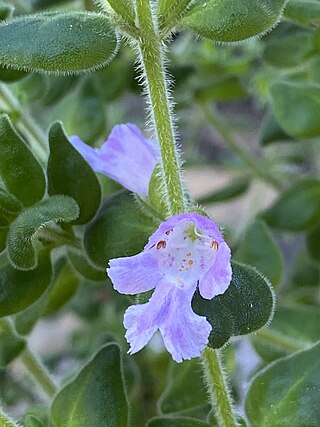
Prostanthera densa, commonly known as villous mint-bush, is a species of flowering plant in the family Lamiaceae and is endemic to near-coastal areas of New South Wales. It is an erect, often compact shrub with aromatic branches, egg-shaped leaves, and mauve flowers with orange markings inside.
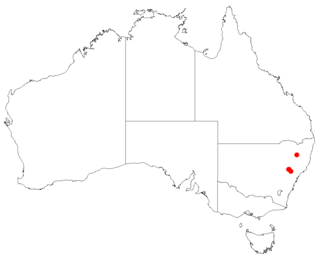
Prostanthera discolor is a species of flowering plant in the family Lamiaceae and is endemic to a small area of New South Wales. It is an open, erect, strongly aromatic shrub with lance-shaped to oblong leaves, and deep mauve to purple flowers with darker spots inside.
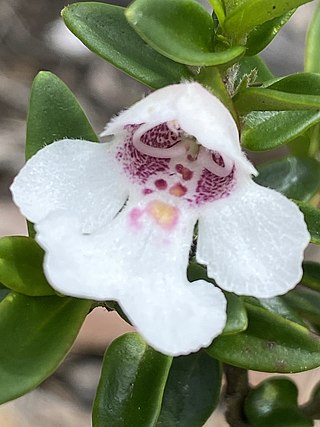
Prostanthera gilesii is a species of flowering plant in the family Lamiaceae and is endemic to the Mount Canobolas area of New South Wales. It is a small, compact, spreading shrub with aromatic, narrow egg-shaped to elliptical leaves, and white to yellowish white flowers with purple to dark mauve markings inside the petal tube and pale orange markings on the petal lobes.

Prostanthera hindii is a species of flowering plant in the family Lamiaceae and is endemic to the Central Tablelands of New South Wales. It is a small, erect shrub with densely hairy branches, egg-shaped leaves, and mauve flowers with deep mauve to dark purple colouration inside the petal tube.

Prostanthera lanceolata is a species of flowering plant in the family Lamiaceae and is endemic to near-coastal area of eastern Australia. It is an erect, aromatic shrub that has stems that are square in cross-section, glandular, egg-shaped leaves and mauve or deep bluish-purple flowers.
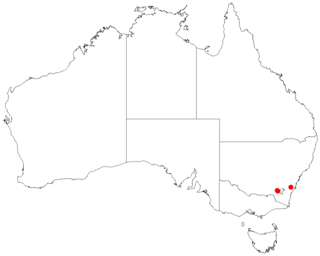
Prostanthera makinsonii is a species of flowering plant in the family Lamiaceae and is endemic to a restricted area of New South Wales. It is a spreading shrub with strongly aromatic, egg-shaped leaves and mostly glabrous purple flowers arranged in bunches of eight to twelve in upper leaf axils.

Prostanthera oleoides is a species of flowering plant that is endemic to central Queensland. It is an open, erect shrub with four-sided branchlets, narrow elliptic, oblong or egg-shaped leaves with the narrower end towards the base, and mauve flowers with purple to dark mauve markings.
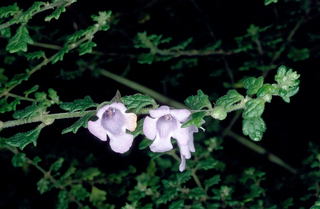
Prostanthera rugosa is a species of flowering plant in the family Lamiaceae and is endemic to a restricted area of New South Wales. It is an openly-branched shrub with egg-shaped or narrow egg-shaped, thick, fleshy leaves and mauve flowers with a white tinge arranged in leaf axils near the ends of branchlets.
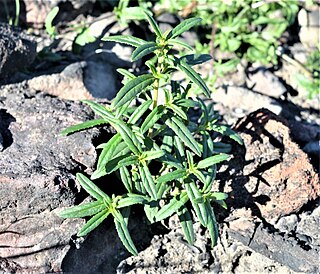
Prostanthera tallowa is a species of flowering plant in the family Lamiaceae and is endemic to the Kangaroo Valley area of New South Wales. It is an erect, aromatic shrub with narrow egg-shaped to linear leaves and mauve to light purple flowers with darker dots inside the petal tube.





















